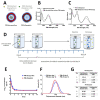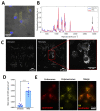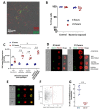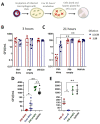Antibiotic-Loaded Polymersomes for Clearance of Intracellular Burkholderia thailandensis
- PMID: 34739227
- PMCID: PMC7612142
- DOI: 10.1021/acsnano.1c05309
Antibiotic-Loaded Polymersomes for Clearance of Intracellular Burkholderia thailandensis
Abstract
Melioidosis caused by the facultative intracellular pathogen Burkholderia pseudomallei is difficult to treat due to poor intracellular bioavailability of antibiotics and antibiotic resistance. In the absence of novel compounds, polymersome (PM) encapsulation may increase the efficacy of existing antibiotics and reduce antibiotic resistance by promoting targeted, infection-specific intracellular uptake. In this study, we developed PMs composed of widely available poly(ethylene oxide)-polycaprolactone block copolymers and demonstrated their delivery to intracellular B. thailandensis infection using multispectral imaging flow cytometry (IFC) and coherent anti-Stokes Raman scattering microscopy. Antibiotics were tightly sequestered in PMs and did not inhibit the growth of free-living B. thailandensis. However, on uptake of antibiotic-loaded PMs by infected macrophages, IFC demonstrated PM colocalization with intracellular B. thailandensis and a significant inhibition of their growth. We conclude that PMs are a viable approach for the targeted antibiotic treatment of persistent intracellular Burkholderia infection.
Keywords: CARS imaging; Raman spectroscopy; antibiotics; imaging flow cytometry; intracellular bacteria; nanoparticles; polymersomes.
Conflict of interest statement
The authors confirm that they have no competing financial interests.
Figures






References
-
- Gilad J, Harary I, Dushnitsky T, Schwartz D, Amsalem Y. Burkholderia mallei and Burkholderia pseudomallei as Bioterrorism Agents: National Aspects of Emergency Preparedness. Israel Medical Association Journal. 2007;9(7):499–503. - PubMed
Publication types
MeSH terms
Substances
Supplementary concepts
LinkOut - more resources
Full Text Sources

